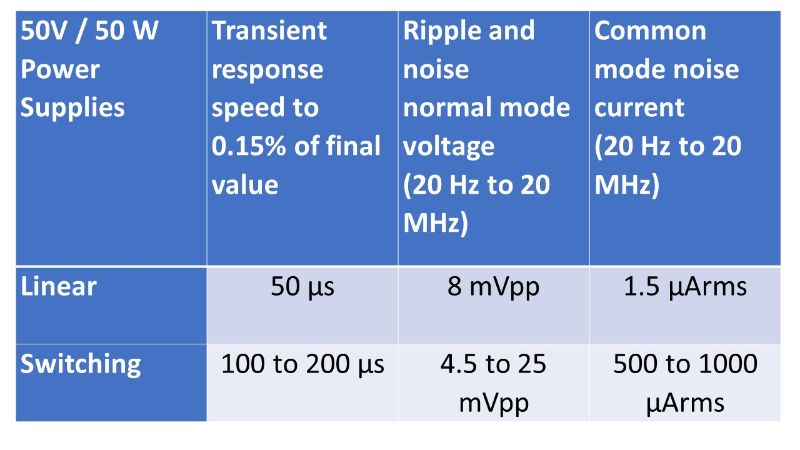
Linear vs. Switching Power Supplies
Linear and switching topologies each have their own strengths and weaknesses. Some clever design work has been put into each of these topologies to mitigate their weaknesses. While additional circuitry adds costs to the products, the result is a power supply that you can trust to power your device. However, even the best power supply should not be used to power every device. It’s important to select a power supply with just a little more power than your device needs without getting too much power. The power supply with the right output power will have lower noise and better device protection regardless of topology.
Linear
Linear power supplies have the following advantages:
- Low output ripple and noise
- Fast transient response
- Low-frequency spectral content
- Reasonable cost for less than 400 W
The inherent disadvantages:
- Low power efficiency
- Relative heavy and sizeable including height
- Above 400 W, high material cost, lack of efficiency generates excessive heat and high operating cost
The sweet spot for linear supplies is for low noise, lower power output where height is not an issue. Keysight uses pre-regulation to overcome the inefficiencies and the heat produced by a linear supply. Pre-regulation adjusts the power applied to the transformer. For smaller loads, the transformer will receive less energy. Most of our bench power supplies under 200 W are linear. With the rise in mobile and other lower power devices, we have re-introduced very low power linear bench supplies, 30 W per output.
Switching power supplies
Switch mode power supplies offer the following benefits:
- Smaller in size and does not require extra height
- High efficiency at all output voltages
- Less expensive
- Can be used to generate high output power
The traditional drawbacks:
- Slower transient response
- Higher output ripple and noise
- High-frequency spectral content
- Common mode noise
The sweet spot for switching power supplies is high power density. In a test system rack space, measured in rack units, is extremely valuable and high-density power supplies are vital. High performance switching power supply uses a more complex topology to reduce noise and improve transient response time. Additional digital filtering reduces the ripple and noise. Finally, a robust mechanical design reduces the emissions of high-frequency noise.

Figure 1. Comparing a 50 V/ 50 W linear supply to a switching supply
Conclusion
Typically, it comes down to cost, size, and power. For testing a low power device on the bench, a linear power supply is a good choice. A linear transformer requires a square package, e.g., a half-rack 2 to 3 U high instrument. As an example, the E3634A a 200W linear power supply has outside dimensions 13.3 cm H X 21.3 cm W X 34 cm D (half rack X 2 U). Physical size is essential both on the bench and in a test system. On the bench, a taller design with a large display is more desirable. Most test engineers prefer a 1 U high full rack width design which is easier to achieve with a switching topology. The N6700 series is an excellent example of using 1 U of rack space very efficiently. For higher power applications a switching topology will provide a compact design at a reasonable price. The N5700 can output 1500 W from a 1 U high design. In most cases, topology is not as important as picking a power supply designed for where you will use it along with the correct power output for your device.
Start building your power supply skill set with our latest ebook and latest bench power supply catalog